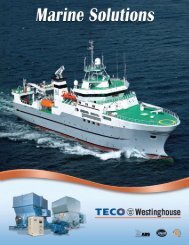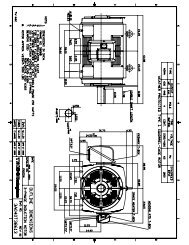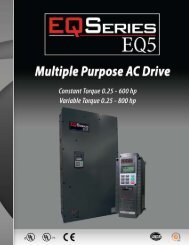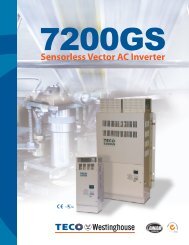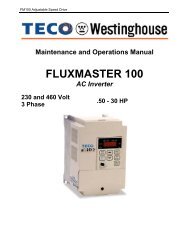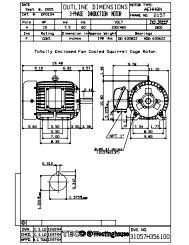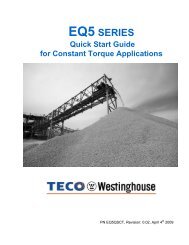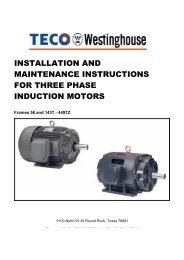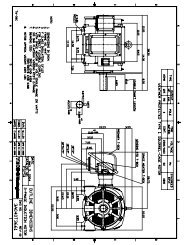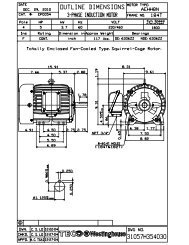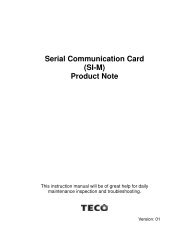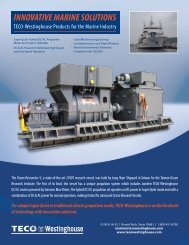EQ7 Series Instruction Manual - TECO-Westinghouse Motor Company
EQ7 Series Instruction Manual - TECO-Westinghouse Motor Company
EQ7 Series Instruction Manual - TECO-Westinghouse Motor Company
You also want an ePaper? Increase the reach of your titles
YUMPU automatically turns print PDFs into web optimized ePapers that Google loves.
The table below lists the available command sources and their symbols.<br />
Available Command Sources<br />
Symbol Command source Symbol Command source Symbol Command source<br />
HAND Keypad MULTI Multi-frequency PID-HAND<br />
12 Terminal [12] PID-P1<br />
C1 Terminal [C1] RS485-1 RS-485 (Port 1) * 1 PID-P2<br />
PID keypad<br />
command<br />
PID command 1<br />
(Analog command)<br />
PID command 2<br />
(Analog command)<br />
12 + C1<br />
Terminal [12] +<br />
Terminal [C1]<br />
RS485-2 RS-485 (Port 2) * 2 PID-U/D<br />
PID UP/DOWN<br />
command<br />
V2 Terminal [V2] BUS Bus option PID_LINK<br />
PID communications<br />
command<br />
U/D UP/DOWN control LOADER<br />
Inverter support<br />
software<br />
"<strong>TECO</strong> Link Software"<br />
PID+MULTI<br />
PID multi-frequency<br />
command<br />
*1 COM port 1 which refers to the RJ-45 connector on the inverter.<br />
*2 COM port 2 which is on the inverter's terminal block.<br />
[ 2 ] Using analog input (F01 = 1 to 3, or 5)<br />
When any analog input (voltage input to terminals [12] and [V2], or current input to terminal [C1]) is selected by<br />
F01, it is possible to arbitrarily specify the reference frequency by multiplying the gain and adding the bias. The<br />
polarity can be selected and the filter time constant and offset can be adjusted.<br />
Adjustable elements of frequency command 1<br />
Data for<br />
F01<br />
Input terminal<br />
1 [12]<br />
Input range<br />
0 to +10 V,<br />
-10 to +10V<br />
Bias<br />
Bias<br />
Base<br />
point<br />
Gain<br />
Gain<br />
Base<br />
point<br />
Polarity<br />
Filter<br />
time<br />
constant<br />
Offset<br />
F18 C50 C32 C34 C35 C33 C31<br />
2 [C1] 4 to 20 mA F18 C50 C37 C39 - C38 C36<br />
3<br />
[12] + [C1]<br />
(Sum of the two<br />
values)<br />
5 [V2]<br />
0 to +10 V,<br />
-10 to +10 V<br />
F18 C50 C32 C34 C35 C33 C31<br />
4 to 20 mA F18 C50 C37 C39 - C38 C36<br />
0 to +10 V,<br />
-10 to +10 V<br />
F18 C50 C42 C44 C45 C43 C41<br />
• Offset (C31, C36, C41)<br />
C31, C36 or C41 specifies an offset for analog input voltage or current. The offset also applies to signals from<br />
external devices (PLCs, Feedback Sensors, Signal Converters, etc…).<br />
• Filter time constant (C33, C38, C43)<br />
C33, C38, or C43 specifies a filter time constant for analog input voltage or current. Choose an appropriate value<br />
for the time constant taking into account the response speed of the machinery system since a large time constant<br />
slows down the response. When the input voltage fluctuates due to noise, specify a larger time constant.<br />
• Polarity (C35, C45)<br />
C35 or C45 specifies the input range for analog input voltage.<br />
Data for C35/C45<br />
0 -10 to +10 VDC<br />
Terminal input specifications<br />
1 0 to +10 VDC (negative value of voltage is regarded as 0 V)<br />
4-28



